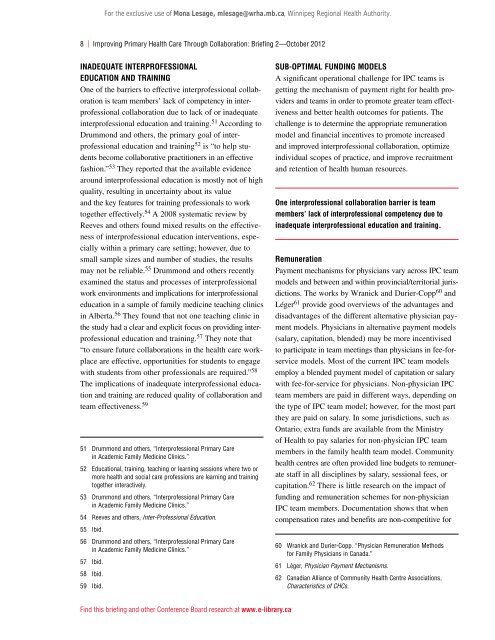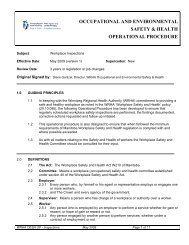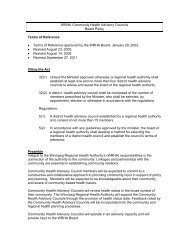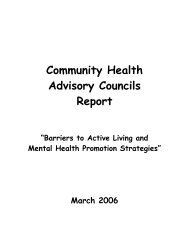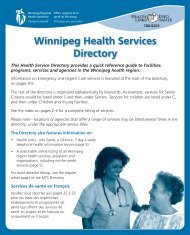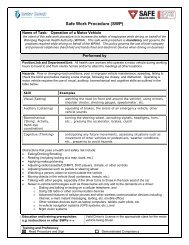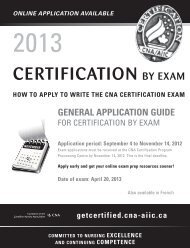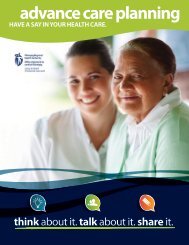Improving Primary Health Care Through Collaboration: Briefing 2 ...
Improving Primary Health Care Through Collaboration: Briefing 2 ...
Improving Primary Health Care Through Collaboration: Briefing 2 ...
- No tags were found...
You also want an ePaper? Increase the reach of your titles
YUMPU automatically turns print PDFs into web optimized ePapers that Google loves.
For the exclusive use of Mona Lesage, mlesage@wrha.mb.ca, Winnipeg Regional <strong>Health</strong> Authority.8 | <strong>Improving</strong> <strong>Primary</strong> <strong>Health</strong> <strong>Care</strong> <strong>Through</strong> <strong>Collaboration</strong>: <strong>Briefing</strong> 2—October 2012Inadequate InterprofessionalEducation and TrainingOne of the barriers to effective interprofessional collaborationis team members’ lack of competency in interprofessionalcollaboration due to lack of or inadequateinterprofessional education and training. 51 According toDrummond and others, the primary goal of interprofessionaleducation and training 52 is “to help studentsbecome collaborative practitioners in an effectivefashion.” 53 They reported that the available evidencearound interprofessional education is mostly not of highquality, resulting in uncertainty about its valueand the key features for training professionals to worktogether effectively. 54 A 2008 systematic review byReeves and others found mixed results on the effectivenessof interprofessional education interventions, especiallywithin a primary care setting; however, due tosmall sample sizes and number of studies, the resultsmay not be reliable. 55 Drummond and others recentlyexamined the status and processes of interprofessionalwork environments and implications for interprofessionaleducation in a sample of family medicine teaching clinicsin Alberta. 56 They found that not one teaching clinic inthe study had a clear and explicit focus on providing interprofessionaleducation and training. 57 They note that“to ensure future collaborations in the health care workplaceare effective, opportunities for students to engagewith students from other professionals are required.” 58The implications of inadequate interprofessional educationand training are reduced quality of collaboration andteam effectiveness. 5951 Drummond and others, “Interprofessional <strong>Primary</strong> <strong>Care</strong>in Academic Family Medicine Clinics.”52 Educational, training, teaching or learning sessions where two ormore health and social care professions are learning and trainingtogether interactively.53 Drummond and others, “Interprofessional <strong>Primary</strong> <strong>Care</strong>in Academic Family Medicine Clinics.”54 Reeves and others, Inter-Professional Education.55 Ibid.56 Drummond and others, “Interprofessional <strong>Primary</strong> <strong>Care</strong>in Academic Family Medicine Clinics.”57 Ibid.58 Ibid.59 Ibid.Sub-Optimal Funding ModelsA significant operational challenge for IPC teams isgetting the mechanism of payment right for health providersand teams in order to promote greater team effectivenessand better health outcomes for patients. Thechallenge is to determine the appropriate remunerationmodel and financial incentives to promote increasedand improved interprofessional collaboration, optimizeindividual scopes of practice, and improve recruitmentand retention of health human resources.One interprofessional collaboration barrier is teammembers’ lack of interprofessional competency due toinadequate interprofessional education and training.RemunerationPayment mechanisms for physicians vary across IPC teammodels and between and within provincial/territorial jurisdictions.The works by Wranick and Durier-Copp 60 andLéger 61 provide good overviews of the advantages anddisadvantages of the different alternative physician paymentmodels. Physicians in alternative payment models(salary, capitation, blended) may be more incentivisedto participate in team meetings than physicians in fee-forservicemodels. Most of the current IPC team modelsemploy a blended payment model of capitation or salarywith fee-for-service for physicians. Non-physician IPCteam members are paid in different ways, depending onthe type of IPC team model; however, for the most partthey are paid on salary. In some jurisdictions, such asOntario, extra funds are available from the Ministryof <strong>Health</strong> to pay salaries for non-physician IPC teammembers in the family health team model. Communityhealth centres are often provided line budgets to remuneratestaff in all disciplines by salary, sessional fees, orcapitation. 62 There is little research on the impact offunding and remuneration schemes for non-physicianIPC team members. Documentation shows that whencompensation rates and benefits are non-competitive for60 Wranick and Durier-Copp. “Physician Remuneration Methodsfor Family Physicians in Canada.”61 Léger, Physician Payment Mechanisms.62 Canadian Alliance of Community <strong>Health</strong> Centre Associations,Characteristics of CHCs.Find this briefing and other Conference Board research at www.e-library.ca


